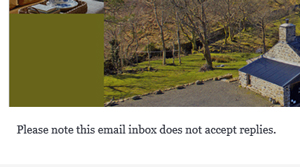
We are visiting relatives at Christmas this year. They’ve got a houseful already, including several lovely but very young children. “Would you mind booking somewhere nearby rather than staying with us?” Hmm, let me think about that.
Two seconds later, I’m on the hunt for a suitable holiday cottage. Shortly after that, we are booked. And shortly after that, I got a survey request. So far, so predictable.
And what’s this? “Please note this email inbox does not accept replies”. Eh?
I get so many of these. So. Many. No-reply. Emails.
Today, I decided to ask for them to stop.
Please note this email inbox does not accept replies.
(Eh?).
Businesses work hard to encourage customer engagement
Most businesses that make their money from direct sales to customers work hard to get those customers. Discounts for new customers. Paid advertisements on search engines. Interesting and attractive websites. Social media campaigns. The cottage business that I booked through even pays other businesses that advertise holidays online to list its cottages – where the whole thing repeats.
That’s fine. I don’t mind being advertised to, on the whole. I’m glad when businesses work hard to make their advertising useful and engaging. I want to be able to find relevant products and experiences. I think these views are not especially radical or unusual.
Why chuck it all away on passive-aggressive content?
They’ve done all that expensive work. They’ve achieved success – converted a potential to an actual customer. And then bam: communication from a no-reply email address. Why?
Why reject the opportunity to turn a silent, slightly engaged customer into a true brand enthusiast? Why work so hard to gain a customer, only to cut off further contact?
If a customer wants to reply to your email, let them. Move some staff from the advertising and marketing departments to reply to those emails. They’ll learn a lot.
Using a third-party service is no excuse. Do some decent content design.
You may reasonably argue that sometimes an email goes out from a third-party service – and you’d be right.
The screenshot I captured is from an email asking me to respond to a questionnaire. The questionnaire came from a third-party service, and maybe, just maybe, it wasn’t practical to find a way to send it from an email address tied to the business. OK, I get it.
If that happens to you, don’t write a passive-aggressive message like “Please note this email inbox does not accept replies”. Instead, unleash your content design skills and write a message that sounds like a human being who is solving a technology problem.
How about: “To contact us, please email contact@businessname.com. This email came from an address that cannot accept replies”. Or maybe keep it even shorter, and delete the replies bit altogether.
To contact us, please email contact@businessname.com
(Ah – that’s better)
You could even go wild, and include a phone number! Maybe even the phone number that the marketing and advertising departments are spending a lot of money to promote?
Even if you’re not selling, avoid no-reply
Not a business? Not selling anything?
Maybe you’re a charity. You’re relying on people to give you money, usually purely altruistically. Do you really want to get passive-aggressive with them?
Maybe you’re a government service, and people have no choice but to use that service. Is turning them away when they try to get in touch to solve a problem really going to help you succeed in your policy objective?
Maybe you’re a hospital or medical service. If you choose where people reply rather than forcing them into finding some other way, you’ll stop those contacts from clogging up inappropriate channels.
Whatever type of organisation you’re working in, if you think about the conversation you are having when you send your email, and give the recipient contact details that are appropriate, then you’ll find that it’s much easier to monitor where contacts arrive from. That will make it much cheaper to find and fix problems, and to make future emails more effective.
Please try to design everything in your emails equally, and test them
If you’re thinking “this a long blog post to moan about 9 words”, you’re right.
Even so, I’m going to make it longer. The little snippet of screenshot I posted only contains a hint of an image – somebody selected that image, and placed it. I haven’t put these details into the screenshot, but I can tell you that someone wrote a cheery message about helping them with a survey. Another detail: A person sat at a computer to type in the words “please feel free to visit our Help Centre” (but forgot to provide a link to the Help Centre).
Your outgoing emails may be a team effort, or they may be done by one person. Please try to think about all the elements in them equally. And above all, please test them:
- Ask an actual customer to open the email while you watch. Get them to tell you what they found in the email and whether it works for them
- Get a colleague to check that everything in the email is in an appropriate tone of voice, with no dead ends
- Check yourself that words that ought to have a link are linked, and that the link works
- And try to reply to one. See what happens.
Then think about what you found and make changes. You’ll get better emails and better customer relationships.
